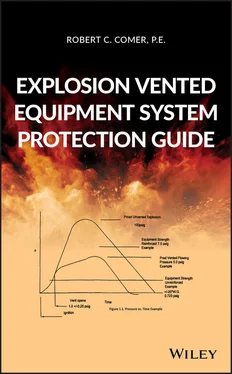Dust collection equipment is normally designed and certified for vacuum (negative pressure) service by the manufacturer; however, when the equipment is subjected to an internal positive pressure due to the vented explosion, P Red, there is the possibility of structural failure. A properly vented system as per NFPA 68 (2013), “Standards on Explosion Protection by Deflagration Venting,” using the deflagration parameters of the combustible dust‐air mixture found by testing in accordance with ASTM E1226‐10, “Standard Test Method for Explosibility of Dust Clouds,” results in a vented explosion flowing pressure, ( P Red), in the equipment that must be contained safely. It has been my experience in analyzing over 200 installations worldwide that the equipment must be reinforced in almost every case to safely contain the vented explosion flowing pressure ( P Red). The explosion relief vent element release pressure (1.0 ± 0.25 psig min.) is usually higher than the equipment allowable pressure (±20″ w.g., 0.723 psig). The cost of reinforcing is usually less expensive than the cost of equipment panels being made of thicker material to contain P Red, or to replace the equipment.
Part 1: Structural Analysis
The analysis in this manual is presented to allow a licensed or competent unlicensed engineer, that by education or experience understands the concepts presented in this book, to determine the required reinforcing design when reviewing the equipment supplied by the manufacturer.
All he/she needs to know is the explosion vent size, the vented explosion flowing pressure, P Red, and the equipment wall material and thickness.
An equipment manufacturer can also use this manual to design their equipment to sustain any pressure dictated by the user after a venting analysis is performed, an explosion relief element is decided on and P Redis determined.
Dust collectors are either cylindrical or square/rectangular shaped. Cylindrical dust collectors are usually structurally sound except for those with a flat roof and an access door that may require reinforcing. Most dust collectors and associated equipment have large, flat, thin panel construction that is very easy to analyze for reinforcing. A weak link in both types of construction is the roof, access door, and door restraints (hinges and latches). In almost every case, the access door and its restraints must be reinforced so that it does not fail and allow hot gas or shrapnel to be discharged into the surrounding area where employees may be working, or other equipment may be damaged. A secondary greater explosion of dust on surfaces in the area by poor housekeeping could occur that could destroy the building structure. Flow activated explosion isolation valves and rotary valves installed in the equipment upstream and downstream of the dust collector contain the combustible dust deflagration products, smoke, dust, burning debris from traveling beyond the equipment.
This section of the book is presented to allow a competent engineer that by education or experience understands the concepts presented in this book, to determine the explosion relief element to safely vent and lower the explosion flowing pressure, P Red, to a reasonable level so that reinforcing, if required, can be analyzed and designed in a practical, economical manner as defined in Part 1.
Required for this section is the process dust explosion characteristics, K st, P max, and the dust handling system geometry. If the dust explosion characteristics are not known, a sample of the dust must be tested to obtain these characteristics. The table of dust characteristic values presented in this book is for estimating purposes only. To ensure proper design, a tested sample of dust must be used.
There are two parts to this book. Part Iprovides the structural analysis and design for reinforcing of dust handling equipment and explosion relief ducting to prevent a catastrophic failure of the equipment during a dust explosion. Part IIprovides the analysis of dust handling equipment to determine the size of the explosion relief burst element and the explosion relief flowing pressure ( P Red) based on the process dust explosion characteristics and geometry of the equipment.
Existing in‐house dust collection systems or new proposed equipment: If the existing or new equipment has been certified by the manufacturer for the allowable safe operating positive pressure on the drawings or in the specifications, it must be determined from the manufacturer, the design criteria that was used (% of yield or ultimate stress). If 2/3 of the 0.2% yield strength was not used as the limiting stress, the equipment does not comply with NFPA 68 (2013) “Standards on Explosion Protection by Deflagration Venting.” Part 1of this book will provide the guidance and structural analysis to ensure that the equipment complies.
If the equipment has been designed to be explosion vented and has an explosion vent built‐in or proposed, there must have been an explosion venting analysis performed specific for the process dust being handled and geometry of the system. If an analysis is provided with the resultant explosion flowing pressure ( P Red), then go to Part 1directly to ensure the integrity of the system. If the manufacturer does not provide the analysis, Part 2of this book will provide the guidance and analysis to size the explosion relief burst element, ducting and to calculate the explosion flowing pressure ( P Red) before accessing Part 1to ensure that the system is structurally sound and safely vented.
Adshear area at minor diameter of bolt, in.2Adoorcross‐sectional area of access door, in.2Apcross‐sectional area of panel, in.2 = Wp tpApinarea of pin, in.2Asshear area, in.2Avcross‐sectional area of vent and minimum annular perimeter area of cage, in.2Awweld area, in.2A1,2,3,4nozzle and reinforcing ring areas, in.2alength of the longest side of the panel, in.blength of the shortest side of the panel, in. (Note: The short side of the panel is always the controlling side in the stress analysis.)bar14.50 psiCdistance from centroidal axis to panel center, in.Cptp/2DLFdynamic load factor = 1.2EYoung's modulus of elasticity in tension and compression, psi (for steel this value is 30 × 106 psi)eefficiency, %Faxial tension in cylinder wall, lbs/in.Faallowable load per pair of welds, lbsfsshear load on bolts, psif1maxmaximum stress at center of panel long edge, psif2maxmaximum stress at center of panel, psif ′combined shear and tension in bolts, psifmaxmaximum stress, psiFTtotal load on bolts, lbsFtuultimate strength of material, psiFty0.2% yield strength of material, psiFrvented reaction force of explosion, lbsFxhorizontal reaction force of vented explosion, lbsFyvertical reaction force of vented explosion, lbsGmodulus of elasticity in shear, psihcylinder wall thickness, in.Hheight of member, in.ICmoment of inertia of composite member, in.4IPmoment of inertia of panel, in.4Kstexplosibility of material, bar‐m/sLlength, span of beam, etc., in.LBload per bolt, lbsLTtotal load on flange, lbsLttotal load on each panel, lbsLcconcentrated load, lbsLwweld length, in.Mmaxmaximum moment, in.‐lbsMoedge moment on panel, in.‐lbsNnumber of boltsPmaxmaximum pressure of deflagration, barPredexplosion flowing pressure, psiPstatvent burst element release pressure, psiQstatical moment of panel about centroidal axis = Ap C, lbs/in.Ravgaverage reaction force normal to panel surface, lbs/in. (a × b × Pred/2a + 2b)Rmaxreaction force normal to the panel surface, lbs/in. (at center of long side)Rl = Rrend reactions on panels and reinforcing members, lbs/in.Rocylinder radius, in.Saallowable stress (2/3 of the 0.2% yield strength), psiScSection modulus of reinforcing composite member, in.3Sstresses in material, psiSuultimate strength of the material, psitpthickness of the panel, in.twweld size, in.Tbolt torque, in.‐lbsTttotal load on panel, lbsTpthickness of reinforcing ring, in.vPoisson's ratioVoshear load on panel edge, lbsVmmaximum vertical shear end reaction load, total load/2, lbsVhhorizontal shear between panel and reinforcing member, = Vm Q/Ic = lbs/in.wuniform edge load acting on the reinforcing member, lbs/in. = Rmax × 2 panelsw.g.water gauge pressure, inches of water, psiWbmaximum individual bolt load, lbsWpwidth of panel or reinforcing ring, in.wt/ftweight per foot of reinforcing member, lbs/ftymaxmaximum deflection of the panel, in.Zdistance of bolt farthest from neutral axis, in.
Читать дальше












